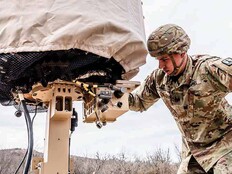IARPA's HAYSTAC Seeks to Monitor and Warn Citizens Proactively
One AI-powered project Marsh teased is the aptly-named HAYSTAC, or Hidden Activity Signal and Trajectory Anomaly Characterization.
It aims to develop “capabilities that produce large-scale microsimulations so that you can figure out human movement and create AI-reasoning engines capable of identifying abnormal movement trajectories and generating normal ones,” Marsh told the symposium’s audience. In plainer terms, given the explosion of data gathered from Internet of Things devices and smart cities technology, the potential exists to better understand normal and abnormal patterns of human movement. With the help of AI, the government could develop more effective and proactive public safety systems and processes.
“As we’re moving through, how can you catch those things that are happening so that we can figure that out ahead of time and create an early warning?” said Marsh.
This could come in handy during a natural disaster or terrorist attack, for example, where most people are fleeing areas as first responders are moving in.
EXPLORE: New technologies that are supporting agencies and citizens.
“Disruptions to roads, bridges or critical infrastructure elements create traffic and cause people to re-route,” according to an IARPA news release. “A rise in civil unrest changes the daily pattern of life as health and basic needs are prioritized over work and recreation. Often the disrupting events themselves are not directly observable, but an understanding of the surrounding movement anomalies can inform timely response and analysis.”
HAYSTAC is in the Broad Agency Announcement period through July 1, during which IARPA solicits research proposals from companies in the private sector. The program is expected to be a four-year effort, beginning in October and ending in March 2026.
“While bringing HAYSTAC to fruition will be a multi-year process, once it’s complete, we’ll have reframed how we look at activity in the world,” HAYSTAC Program Manager Jack Cooper said in the news release. “And it won’t be a static concept of where things are on a map but a dynamic one based on how they’re moving and what’s out of the ordinary.”
HIATUS Helps Identify and Combat Disinformation Campaigns
While AI is being put to work to enhance physical safety and security, it’s also exploring how to better sort and understand intangible things, like human expression. IARPA’s HIATUS (Human Interpretable Attribution of Text Using Underlying Structure) program seeks “to develop novel, human-usable AI systems for attributing authorship and protecting author privacy through identification and leveraging explainable linguistics,” helping solve a problem for intelligence agencies, she said.
Timothy McKinnon, the IARPA program manager leading this work, recently told Nextgov, “Just think about if you had 100 different people, and you ask them to describe some simple thing — like how to open a door — in two sentences or one sentence. You’d probably get about 100 different answers, right? And each person sort of has their own idiosyncrasies as an author that are potentially used by authorship attribution systems.”
LEARN ABOUT: Swarm intelligence: What is it and how are agencies using it?
The program aims to identify stylistic features, such as syntax, that can help identify who wrote a given text, much like a fingerprint, McKinnon said.
“The technology would be able to identify that fingerprint compared against a corpus of other documents and match them up if they are from the same author,” he said. “On the privacy side, the technology would figure out ways that text could be modified, so that it no longer looks like a person’s writing.”
The HIATUS effort has the potential to be game-changing for tracking disinformation campaigns and helping combat human trafficking and other malicious activities on online text forums, McKinnon told the outlet.











